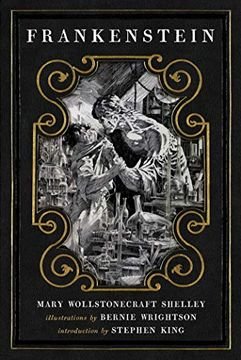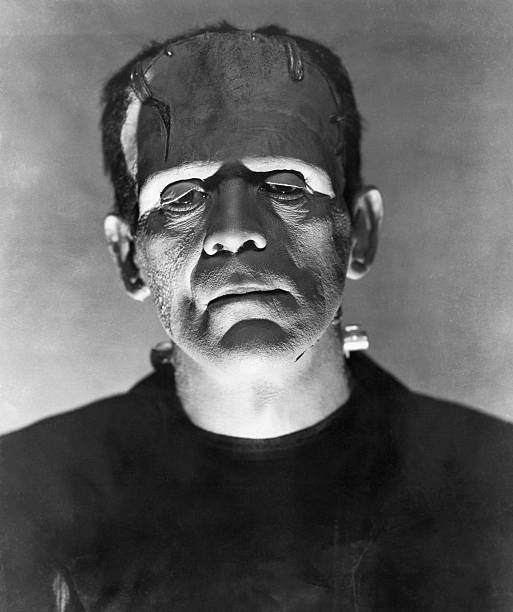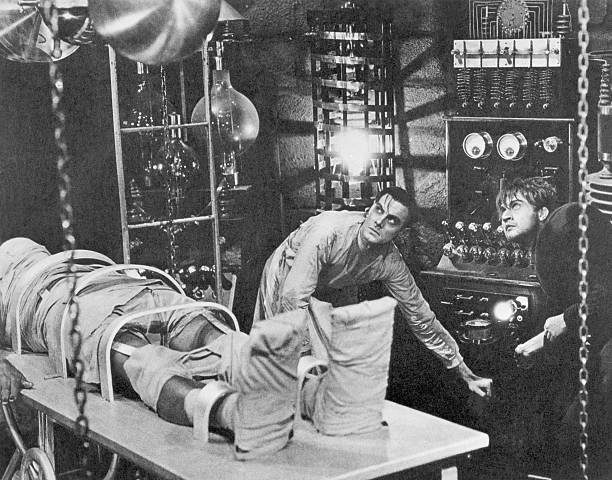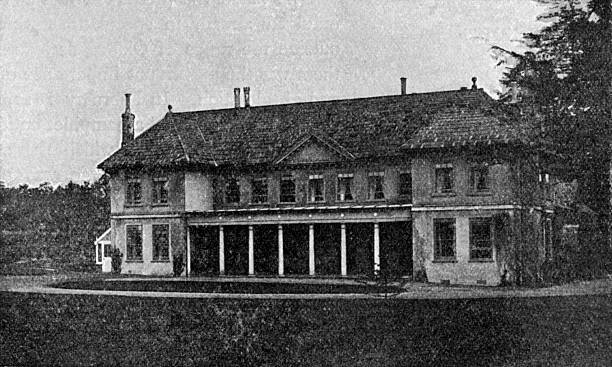¡Está vivo! - Reseña a Frankenstein, de Mary Shelley / He's Alive! - Review of Mary Shelley's Frankenstein (esp-eng)
“Vi al pálido estudiante de sacrílegas ciencias hincado frente al monstruo que había construido”
Mary Shelley
(fragmento del prólogo en la edición de 1931)
Hola, amigos de la buena literatura.
Viajemos hasta una villa de nombre Diodati, cerca de Ginebra, Suiza, lo hacemos además hasta 1816 y vemos a una joven de diecisiete años que, a partir de una apuesta entre cuatro amigos acerca de escribir una historia de terror, se empeña en cumplir lo prometido y al terminar la titula Frankenstein o el moderno Prometeo.
Para ellos y el resto de la población, aquel verano fue extraño y lo llamaron El verano sin verano. Además de oscuro tuvo temperaturas promedio de cuatro grados y en esas atípicas condiciones atribuidas a la erupción del volcán Tambora, se escuchó en la madrugada a una criatura quejarse, un alumbramiento eterno.
Nace como un cuento y es su esposo, el célebre poeta Percy Shelley, quien le sugiere una noche en el lecho que lo extienda hasta los confines de la novela. La joven Mary veía poco tiempo después, el 1 de enero de 1818, la primera publicación de su hijo literario y con esto nacía además un referente del terror gótico, un desafío al mismísimo orden de Dios.
Aunque la historia menciona con frecuencia aquel juego literario y fantasmal en Diodati, mansión alquilada por Lord Byron, lo cierto en la influencia de esta obra es la muerte de su madre, la feminista y filósofa Mary Wollstoncraft, diez días después de dar a luz a nuestra Shelley. El fallecimiento de seres importantes en su vida fue una marca, abortó cuatro veces y su único hijo murió siendo niño. Hay en Frankenstein ese deseo de regresar a la vida a alguien que ya no está. Frankenstein, que no es el monstruo como tanta gente cree, sino el apellido del científico Víctor, su creador, establece un paralelo con el mito griego de Prometeo. Recordemos que este desafía a Zeus y a través del fuego brinda la posibilidad a los humanos de desarrollar su capacidad creativa. El dolor por la pérdida la acompañó siempre y debió ser triste verla ir hacia la tumba de su madre con regularidad, y sentarse junto a ella para tener largas conversaciones.
El cine le da la bienvenida a su novela en 1910 a través de un cortometraje mudo del director J. Searle Dawley, y desde entonces mantiene cerca de treinta adaptaciones, y más de ciento veinte si tenemos en cuenta el teatro y la televisión. He visto algunas y no son tan fieles a la esencia, un cuestionamiento sobre las normas sociales (Mary la publicó bajo seudónimo, y tardó unos años en firmar con su nombre debido a la presión masculina sobre las mujeres), y un símbolo de los aires revolucionarios imperantes en la Europa de 1700, sobre todo en su última década, entonces desaparecidos en las noches donde en la mansión Diodati se escucharon los dolores del parto.
Mi adaptación favorita es Frankenstein, de 1931, con un actor que llegaba al papel por accidente. Por entonces la mira estaba en Bela Lugosi, pero este rechazó el trabajo por creer que sus fans no lo reconocerían detrás del maquillaje. Boris Karloff, quien en realidad se llamaba William Henry Pratt, aprovechó la oportunidad para luego convertirse en el monstruo más icónico de las diferentes adaptaciones.
Por cierto, pagó un precio por el estrellato y fueron los problemas en la espalda para siempre, a causa del traje, muy apretado según dicen, y el encasillamiento, porque después de esto solo se le quería para seguir interpretando al monstruo. Aunque lo segundo no le molestó demasiado, no a alguien que apenas recibió papeles muy pequeños y antes, condujo camiones por Canadá para ganarse la vida.
Esta gran obra de la literatura universal nos lleva a una larga reflexión acerca de quiénes son los verdaderos seres despreciables, cómo manejamos a lo largo del tiempo nuestras emociones y sentimientos más profundos. Qué elementos o condiciones deciden lo que hacemos con el bien y el mal que llevamos dentro. Expone magistralmente nuestro miedo a lo desconocido y la forma equivocada en que la mayoría de las veces reaccionamos ante ello. La ética humana bajo la lupa. También quedan expuestas nuestra soberbia y la arrogancia. Hay, en medio de todo, un canto triste a la soledad de la propia escritora.
No es la novela un atractivo técnico, un modelo de virtuosismo, pero no se debe olvidar la edad que tenía Shelley cuando la escribió. Pocos, probablemente ningún otro mortal, podría ni podrá crear en la adolescencia semejante pasaje de largo aliento a la eterna pregunta que nos arroja la muerte.
“Quien no haya experimentado la seducción que la ciencia ejerce sobre una persona, jamás comprenderá su tiranía”.
Víctor Frankenstein
“Maldito creador! ¿Por qué me hiciste vivir? ¿Por qué no perdí en aquel momento la llama de la existencia que tan imprudentemente encendiste?”
La criatura
English version
“I saw the pale student of sacrilegious sciences kneeling before the monster he had constructed.”
Mary Shelley
(excerpt from the prologue in the 1931 edition)
Hello, friends of good literature.
Let's travel to a village named Diodati, near Geneva, Switzerland. We also travel to 1816 and see a seventeen-year-old girl who, following a bet between four friends about writing a horror story, is determined to keep her promise and, upon finishing it, titles it Frankenstein, or the Modern Prometheus.
For them and the rest of the population, that summer was strange, and they called it The Summer Without a Summer. In addition to being dark, the average temperature was four degrees Celsius, and in these atypical conditions attributed to the eruption of the Tambora volcano, a child was heard moaning in the early morning, an eternal birth.
It began as a short story, and it was her husband, the celebrated poet Percy Shelley, who suggested a night in bed that she expand it to the confines of a novel. Shortly thereafter, on January 1, 1818, young Mary saw the first publication of her literary son, and with this, a symbol of Gothic horror was born, a challenge to God's very order.
Although the story frequently mentions that literary and ghostly game at Diodati, a mansion rented by Lord Byron, the true influence of this work lies in the death of his mother, the feminist and philosopher Mary Wollstoncraft, ten days after giving birth to our Shelley. The death of important people in her life left a mark; she miscarried four times, and her only son died as a child. In Frankenstein, there is that desire to bring back to life someone who is no longer there. Frankenstein, who is not the monster as many people believe, but the surname of the scientist Victor, his creator, establishes a parallel with the Greek myth of Prometheus. Let's remember that this novel challenges Zeus and, through fire, offers humans the opportunity to develop their creative capacity. The pain of loss was always with her, and it must have been sad to see her regularly visit her mother's grave and sit beside it for long conversations.
Cinema welcomed her novel in 1910 through a silent short film by director J. Searle Dawley, and since then, it has had nearly thirty adaptations, and more than one hundred and twenty if we count theater and television. I've seen some, and they're not as faithful to its essence: a questioning of social norms (Mary published it under a pseudonym and took a few years to sign with her own name due to male pressure on women), and a symbol of the revolutionary airs prevailing in Europe in the 1700s, especially in its last decade, then lost in the nights when the pains of labor could be heard in the Diodati mansion.
My favorite adaptation is Frankenstein, from 1931, with an actor who landed the role by accident. At the time, the focus was on Bela Lugosi, but he turned down the role because he believed his fans wouldn't recognize him behind the makeup. Boris Karloff, whose real name was William Henry Pratt, seized the opportunity to later become the most iconic monster of the various adaptations.
Incidentally, he paid a price for stardom, and it was back problems forever, due to the suit, which was said to be too tight, and typecasting, because after that, he was only wanted to continue playing the monster. Although the latter didn't bother her too much, not someone who only received very small roles and previously drove trucks across Canada to earn a living.
This great work of universal literature leads us on a long reflection about who the truly despicable beings are, how we manage our deepest emotions and feelings over time. What elements or conditions decide what we do with the good and evil we carry within us. It masterfully exposes our fear of the unknown and the misguided way we often react to it. Human ethics under the microscope. Our pride and arrogance are also exposed. Amidst it all, there is a sad ode to the writer's own loneliness.
The novel is not a technical attraction, a model of virtuosity, but one must not forget the age that Shelley said when she wrote it. Few, probably no other mortal, could or will ever be able to create in adolescence such a long-winded passage to the eternal question that death throws at us.
“Whoever has not experienced the seduction that science exerts over a person will never understand its tyranny.”
Victor Frankenstein
“Cursed creator! Why did you make me live? Why did I not lose at that moment the flame of existence that you so recklessly lit?”
The creature




Es un clásico que me falta leer, espero hacerlo este año. ¿Qué tan fácil es de leer?